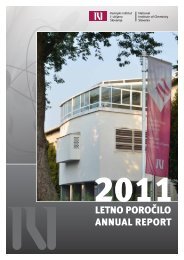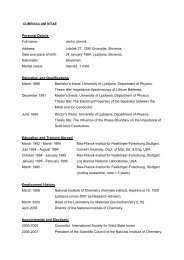Letno poročilo 2005
Letno poročilo 2005
Letno poročilo 2005
Create successful ePaper yourself
Turn your PDF publications into a flip-book with our unique Google optimized e-Paper software.
Laboratorij za prehrambeno kemijo<br />
Laboratory for Food Chemistry<br />
90<br />
intenziteto in ton barve, ve~ vitamina C, poleg<br />
antocianinov, zna~ilnih za jagodni nektar, so<br />
vsebovali {e antocianine ~rnega ribeza. Med<br />
staranjem so se vsebnosti merjenih parametrov<br />
v nektarjih z dodatki koncentratov<br />
bolje ohranile, predvsem Pg3G, zna~ilen za<br />
barvo jagode. Senzori~no so bili takoj in po<br />
staranju bolje ocenjeni nektarji z dodanimi<br />
koncentrati. Sedaj se dogovarjamo {e za<br />
industrijsko uporabo pripravljenih koncentratov.<br />
- V okviru EU projekta TOM so bile na{e<br />
raziskave usmerjene v izolacijo biolo{ko<br />
aktivnih spojin prisotnih v odpadkih iz<br />
proizvodnje izdelkov iz paradi`nika. Ugotovili<br />
smo, da vzorci vsebujejo precej triterpenoidov,<br />
od katerih smo uspeli identificirati<br />
in pribli`no ovrednotiti amirin v CO 2 ekstraktih<br />
ostankov po predelavi paradi`nika. Razvili<br />
smo nov postopek ekstrakcije in izolacije dveh<br />
encimov pektin metilesteraze (PME) in<br />
poligalakturonaze (PG) iz paradi`nika. Izolirali<br />
smo eno od oblik PG in eno od oblik PME, ki<br />
za svoje delovanje ne potrebuje natrijevega<br />
klorida in bi jo lahko uporabili v prehrambeni<br />
industriji. Za izolacijo so bile klju~nega<br />
pomena kratke monolitne kolone (CIM ® diski)<br />
podjetja BIA Separations d.o.o., Ljubljana.<br />
Oba encima (PG in PME), ki smo ju uspeli<br />
izolirati ~ista in z ohranjeno aktivnostjo, je<br />
nizozemsko podjetje Catchmabs uporabilo za<br />
generiranje monoklonskih protiteles iMab in<br />
nato za razvoj metode za direktno izolacijo<br />
teh encimov iz ekstrakta paradi`nika z<br />
afinitetno kromatografijo.<br />
- Raziskovali smo tudi, kak{en vir karotenoida<br />
likopena (rde~ega barvila zrelega paradi`nika)<br />
so razli~ni komercialni izdelki na slovenskem<br />
tr`i{~u (pasirani paradi`nik, ke~api, dvojni<br />
koncentrati, prehranski dodatek likopena v<br />
obliki tablet, itd). Ekstrakcija likopena in<br />
priprava testne raztopine iz razli~nih vzorcev<br />
predstavljata najbolj kriti~no fazo analize.<br />
Lo~bo velikega {tevila geometrijskih izomer<br />
likopena smo izvedli na koloni C30, z<br />
and one form of PG were isolated using short<br />
monolithic columns (CIM ® disks, Bia Separations<br />
d.o.o., Ljubljana, Slovenia). Both enzymes<br />
(pure PME and pure PG with preserved<br />
activity) were used in the year <strong>2005</strong> by the<br />
company Catchmabs (Wageningen) as targets<br />
for the iMab generation, and thereafter<br />
for the development of the method for the<br />
direct isolation of these enzymes from tomato<br />
extract by means of affinity chromatography.<br />
- We investigated also what source of carotenoid<br />
lycopene are different commercial products<br />
on Slovenian market (tomato purees,<br />
ketchups, double concentrates, a dietary supplement<br />
formulated as tablets, etc). Extraction<br />
of lycopene and preparation of the test<br />
solutions was found to be the most critical<br />
phase of the analysis. The separation of a<br />
great number of geometrical isomers of<br />
lycopene was performed on the column C30<br />
using a single component mobile phase,<br />
which is a big advantage of our method compared<br />
to the published methods. So we determined<br />
not only the total content of<br />
lycopene in different samples but also the<br />
content of isomers.<br />
- In the frame of cooperation with the group<br />
from University of Helsinki (Faculty of Pharmacy,<br />
Finland) we finished the work about<br />
the TLC separation of catechins. With the<br />
partners from Palacky University (Faculty of<br />
Medicine, Institute of Medical Chemistry and<br />
Biochemistry, Olomuc, Czech Republic) we<br />
investigated biological and chemical variability<br />
of yacon (Smalanthus sonchifolius). Colleagues<br />
from the Institute for hop and brewing<br />
industry from @alec, Slovenia, prepared<br />
us the first group of samples of roots of plants<br />
from Boraginaceae family containing bioactive<br />
naphtoquinones. Within the collaboration<br />
with researchers from Biotechnical<br />
Faculty (Department of Agronomy, Ljubljana,<br />
Slovenia), we performed some preliminary<br />
experiments with cuticular extracts of cabbage.<br />
Samples were taken from cabbages







